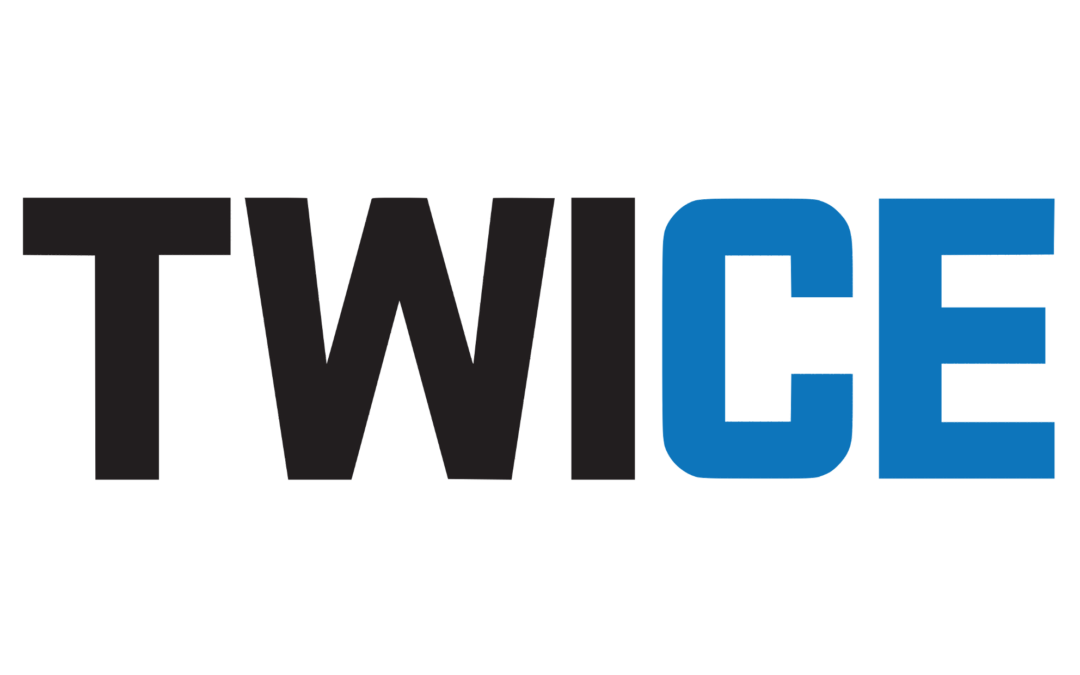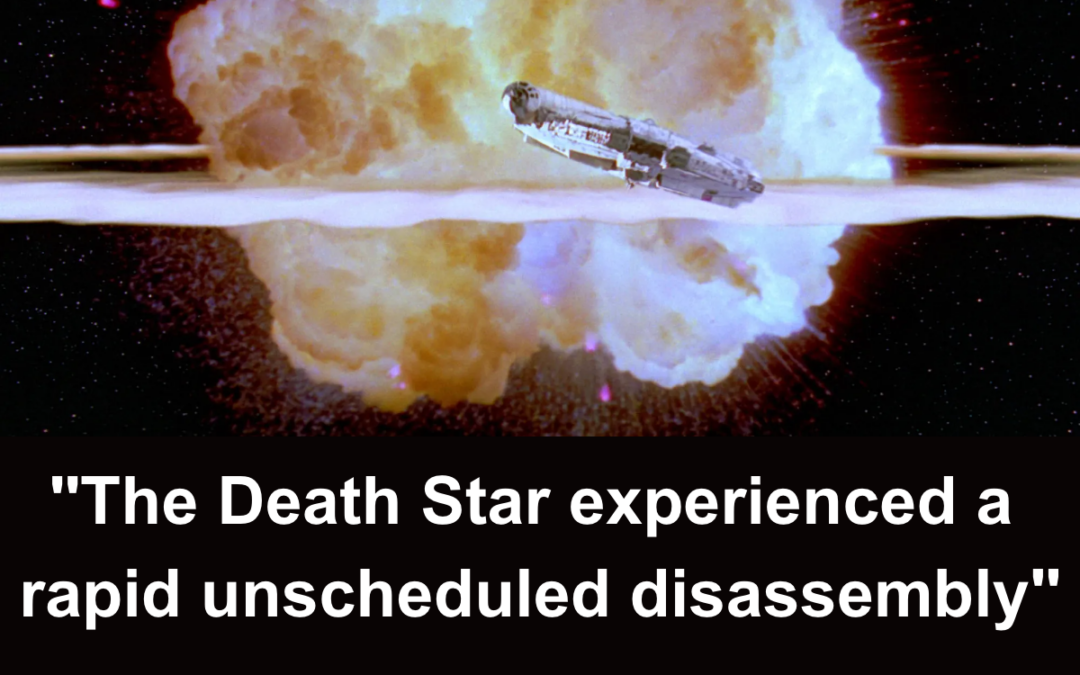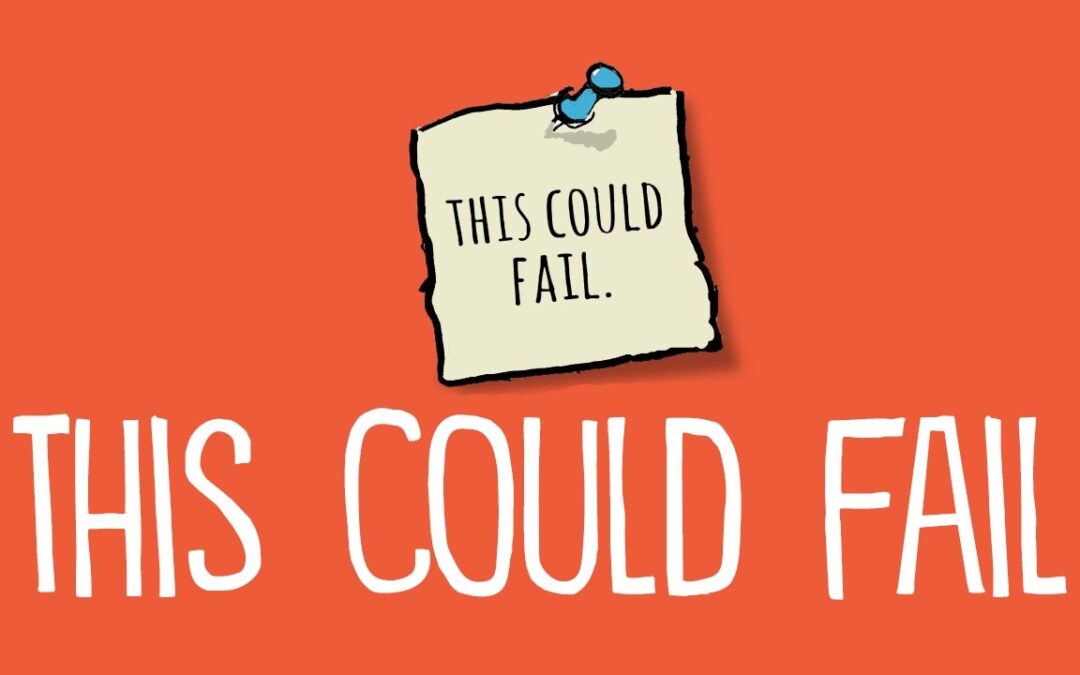


Yes, You CAN Fail Your Way To Success. Here’s How.
“Rapid Unscheduled Disassembly”
It’s a meme and my new favorite euphemism for getting dumped/fired (as in, “There was a rapid unscheduled disassembly of our relationship.” Thank you, social media, for this gem)
It’s also spurred dozens of conversations with corporate leaders and innovation teams about the importance of defining success, the purpose of experiments, and the necessity of risk.
Define Success so You Can Identify Failure
The dictionary defines “fail (verb)” as “be unsuccessful in achieving one’s goal.”
But, as I wrote last week, using your definition of success to classify something as a failure assumes you defined success correctly.
Space X didn’t define success as carrying “two astronauts from lunar orbit to the surface of the moon,” Starship’s ultimate goal.
It defined success in 3 ways:
- Big picture (but a bit general) – Validating “whether the design of the rocket system is sound.”
- Ideal outcome – “Reach an altitude of 150 miles before splashing down in the Pacific Ocean near Hawaii 90 minutes [after take-off].”
- Base Case – Fly far enough from the launchpad and long enough to generate “data for engineers to understand how the vehicle performed.”
By defining multiple and internally consistent types of success, SpaceX inspired hope for the best and set realistic expectations. And, if the rocket exploded on the launchpad? That would be a failure.
Know What You Need to Learn so You Know What You Need to Do
This was not the first experiment SpaceX ran to determine “whether the design of the rocket system was sound.” But this probably was the only experiment they could run to get the data they needed at this point in the process.
You can learn a lot from lab tests, paper prototypes, and small-scale experiments. But you can’t learn everything. Sometimes, you need to test your idea in the wild.
And this scares the heck out of executives.
As the NYT pointed out, “Big NASA programs like the Space Launch System…are generally not afforded the same luxury of explode-as-you-learn. There tends to be much more testing and analysis on the ground — which slows development and increases costs — to avoid embarrassing public failures.”
Avoiding public failure is good. Not learning because you’re afraid of public failure is not.
So be clear about what you need to learn, all the ways you could learn it, and the trade-offs of private, small-scale experiments vs. large-scale public ones. Then make your choice and move forward.
Have Courage. Take a Risk
“Every great achievement throughout history has demanded some level of calculated risk, because with great risk comes great reward,” Bill Nelson, NASA Administrator.
“Great risk” is scary. Companies do not want to take great risks (see embarrassing public failure).
“Calculated risk” is smart. It’s necessary. It’s also a bit scary.
You take a risk to gain something – knowledge, money, recognition. But you also create the opportunity to lose something. And since the psychological pain of losing is twice as powerful as the pleasure of gaining, we tend to avoid risk.
But to make progress, you must take a risk. To take a risk, you need courage.
And courage is a skill you can learn and build. For many of us, it starts with remembering that courage is not the absence of fear. It is the choice to take action despite fear.
When faced with a risk, face it. Acknowledge it and how you feel. Assess it by determining the best, worst, and most likely scenarios. Ask for input and see it from other people’s perspectives. Then make your choice and move forward.
How to know when you’ve successfully failed
Two quotes perfectly sum up what failure en route to success is:
“It may look that way to some people, but it’s not a failure. It’s a learning experience.”- Daniel Dumbacher, executive director of the American Institute of Aeronautics and Astronautics and a former high-level NASA official.
“Would it have been awesome if it didn’t explode? Yeah. But it was still awesome.” – Launch viewer Lauren Posey, 34.

What is failure?
A couple of weeks ago, I wrote about my hatred of failure while acknowledging that there are things I hate more (inertia, blind allegiance to the status quo, unwillingness to try) that motivate me to risk it.
In response, I received this email from my friend and former colleague Daymara, now the Founder & CEO of Rockin’ Baker in Fayetteville, AR (shared here with her permission)
I’m the opposite. I love failing! That’s when I learn the most, that I question what and how I could better, question more and more. It triggers my brain to look back, re-evaluate, assess and spring forward. I wouldn’t be here today if I had not risked. I don’t think anyone starts anything thinking when they’d fail. But some of us aren’t afraid or hate it. I wouldn’t be here if I hate failing, wouldn’t have left my country looking for a safer place, wouldn’t have launched RBI because I didn’t have any entrepreneurial experience not even in the hospitality industry, wouldn’t have switched to focus on neurodiversity and so much more.
.
Because I came to the US, I got to meet you. Yes, I failed at seeing the signs & lost over 60% of my savings just 2 weeks before leaving Venezuela. I could’ve decided to stay because maybe it was going to be harder and the risk of failing in a country I didn’t know higher. I had a plan. If it didn’t work, come back home & start all over again.
.
I started RBI understanding that I could fail. I told myself, if I did, at least I would have an answer. Yes, I’m failing terribly at making this social enterprise work. Yet, I’ve gained so much knowledge about humanity, our differences, the unfairness that neurodivergents have to live daily, running a social enterprise and so much more. If I had hated failing, I wouldn’t be sharing my experience with other entrepreneurs so they don’t make the same mistakes I made. I wouldn’t be advocating for more equitable places for all, including women.
.
Failing feeds me to do better, to ask more questions, to explore more, to lead me to become better. I don’t love failing, I welcome it.
.
My first thought was, “Wow, this is so healthy! I wish more people felt and acted this way!”
My second thought was, “I wouldn’t apply the word ‘fail’ to any of these situations. You’re trying, learning, changing, and trying again.:
Just because you don’t get the expected outcome the first time doesn’t mean you failed.
Or does it?
What the Dictionary Says
According to Oxford Languages, “fail” (verb) means
- Be unsuccessful in achieving one’s goal, “he failed in his attempt to secure election.”
- Neglect to do something, “the firm failed to give adequate risk warnings.”
- Break down; cease to work well, “a truck whose brakes had failed.”
True but contextual:
- If success is defined as launching a new product, but customer feedback proves there’s no demand or willingness to pay, is shutting it down a failure?
- If you neglect something that isn’t important or doesn’t have significant ramifications, like not eating breakfast, did you fail or simply forget, run out of time, or make a mistake?
- If something works but not well, like an expense reporting system, is it a failure or just burdensome, a pain, or a necessary evil?
Also, incomplete.
What People Say
“Fail” has so many definitions and meanings in Daymara’s telling of her story. In addition to some of the dictionary’s definitions, she also uses “Fail” to mean:
- Take smart risks, “I could’ve decided to stay because maybe it was going to be harder and the risk of failing in a country I didn’t know higher. I had a plan. If it didn’t work, come back home & start all over again.”
- Get new information to facilitate learning,
- “I’m the opposite. I love failing! That’s when I learn the most, that I question what and how I could better, question more and more. It triggers my brain to look back, re-evaluate, assess and spring forward.”
- I started RBI understanding that I could fail. I told myself, if I did, at least I would have an answer.
- Adapt and change based on learning, “wouldn’t have switched to focus on neurodiversity”
- Grow, improve, evolve, “Failing feeds me to do better, to ask more questions, to explore more, to lead me to become better. I don’t love failing, I welcome it.”
What Do You Say?
Like “Innovation,” “Failure” is a word we all use A LOT that no longer has a common definition. In the dictionary, failure is bad and to be avoided. To Daymara and scores of entrepreneurs and innovators, failure is wonderful and welcome.
Progress, either towards or away from failure, requires us to define “Failure” for ourselves and our work and agree on a definition with our teammates.
So, tell me:
- What is failure to you?
- To your team?
- To your boss?

Cede or Seed: What’s Your Innovation Strategy?
To Cede, or to Seed, that is the question:
Whether ‘tis nobler in the mind to suffer
The slings and arrows of a down quarter or year,
Or to take arms against the Tyranny of Now
And by opposing overcome it.
To Cede – to withdraw,
Spend no more; and by stopping to say we end
The innovation and the thousand natural insights
That pave the way: ‘tis a necessity
Stoically to be endured
To Seed, to spend;
To spend perchance to grow – ay there’s the rub:
For in that spending on innovation what revenue may come,
When we have emerged from this uncertainty,
Must give us hope – there’s the advantage
That makes success of such a business
- Hamlet, if he were a senior executive making budget decisions during periods of uncertainty (and with my deepest apologies to Shakespeare)
The Question
To cede or seed is the question facing so many executives right now.
The same question faced executives in 2001, 2008, and 2020.
And an answer is required.
But what’s the right answer?
As a friend likes to say, “It’s contextual.”
To Cede
Cede is the most common answer for two main reasons: (1) executives feel they don’t have a choice because super-senior executives mandated an x% budget, or (2) executives need to boost results by allocating resources to things with “guaranteed” ROI.
Whatever the reason, innovation is a luxury the business can no longer afford, and the core business is a necessity to be supported at all costs. As a result, rather than scaling back a little in a lot of places, managers believe it is safer and easier to eliminate innovation entirely and maintain, or even increase, resources for operations.
Sometimes, this is also the right answer.
If the business is hemorrhaging cash, its value is plummeting, and people are questioning whether or not it can stay in business, then Cede is the right answer. There’s no sense in investing for success in one, three, or five years if there’s little chance of seeing the next day, week, or month.
But odds are, you’re not in that situation.
To Seed
The Dot-com bubble. The Great Recession. COVID-19 recession.
The 21st century has allowed us to study the impact of different decisions during and after economic crises.
And when it comes to innovation, evidence shows that companies that continue to invest in innovation during times of economic uncertainty outperformed the market by 10% during the crisis and by up to 30% in the five years immediately following the crisis.
But not all companies.
A study of 4,700 companies during three global recessions (1980 – 1982, 1990 – 1991, and 2000 – 2002) found that “Businesses that boldly invest more than their rivals during a recession… enjoy only a 26% chance of becoming leaders after a downturn.” However,
“Companies that master the delicate balance between cutting costs to survive today and investing to grow tomorrow do well after a recession. Within this group, a subset that deploys a specific combination of defensive and offensive moves has the highest probability—37%—of breaking away from the pack. These companies reduce costs selectively by focusing more on operational efficiency than their rivals do, even as they invest relatively comprehensively in the future by spending on marketing, R&D, and new assets. Their multipronged strategy…is the best antidote to a recession.”
The takeaway – Seed, don’t splurge.
The Answer (sort of)
It’s easy, and incredibly biased, of me to assert that there is one and only one right answer. That the executive who cuts innovation spending (along with travel budgets and probably a few other things) is woefully short-sighted and dooming his business to a never-ending cycle of cutting back, losing ground, and racing to catch up, only to cut again when the next downturn hits.
It’s also very unfair because I’d be using history and theory to judge an executive grappling with the reality of organizational mandates, limited resources, and very real responsibilities.
The right answer is the one you can live with.
Ceding makes sense in the short term, but it’s a liability in the medium and long term.
Seeding pays off in 2-3 years, but you’ll endure skepticism and risk your bonus or job while waiting.
Research says Seeding is the right answer.
Reality often dictates Ceding.
The choice is yours.
Just remember that, like Hamlet, you live (or die) with the results.

The 3 Types of Innovation Are Not What You Think They Are (But They Do Determine Your Success)
The Official Story
“Innovation” is not peanut butter.
You can’t smear it all over everything and expect deliciousness.
When discussing innovation, you must be specific so people know what you expect. This is why so many thought leaders, consultants, and practitioners preach the importance of defining different types of innovation.
- Clayton Christensen encourages focusing on WHY innovation is happening – improve performance, improve efficiency, or create markets – in his 2014 HBR article.
- The classic Core/Adjacent/Transformational model focuses on WHAT is changing – target customer, offering, financial model, and resources and processes.
- McKinsey’s 3 Horizons focus on WHEN the results are achieved – this year, 2-3 years, 3-6 years.
It’s easy to get overwhelmed by the options and worry about which approach is “best.” But, like all frameworks, they’re all a little bit right and a little bit wrong, and the best one is the one that will be used and get results in your organization.
The REAL story
Everything in the official story is true, but not the whole truth.
“Innovation” is not peanut butter.
You can’t smear it all over everything and expect deliciousness.
When doing innovation, you must remember your customer – the executives who make decisions, allocate resources, and can accelerate or decimate your efforts.
More importantly, you need to remember their Jobs to be Done (JTBD) – keep my job, feel safe and respected, and be perceived as competent/a rising star – because these jobs define the innovations that will get to market.
3 REAL types of innovation
SAFE – The delightful solution to decision-makers’ JTBD
Most closely aligned with Core innovation, improving performance or efficiency, and Horizon 1 because the focus is on improving what exists in a way that will generate revenue this year or next. Decision-makers feel confident because they’ve “been there and done that” (heck, doing “that” is probably what got them promoted in the first place). In fact, they’re more likely to get in trouble for NOT investing in these types of innovations than they are for investing in them.
STRETCH – The Good Enough solution
Most like Adjacent innovation because they allow decision-makers to keep one foot in the known while “stretching” their other foot into a new (to them) area. This type of innovation makes decision-makers nervous because they don’t have all the answers, but they feel like they at least know what questions to ask. Progress will require more data, and decisions will take longer than most intrapreneurs want. But eventually, enough time and resources (and ego/reputation) will be invested that, unless the team recommends killing it, the project will launch.
SPLATTER – The Terrible solution
No matter what you call them – transformational, radical, breakthrough, disruptive, or moonshots – these innovations make everyone’s eyes light up before reality kicks in and crushes our dreams. These innovations “define the next chapter of our business” and “disrupt ourselves before we’re disrupted.” These innovations also require decision-makers to let go of everything they know and wander entirely into the unknown. To invest resources in the hope of seeing the return (and reward) come back to their successor (or successor’s successor). To defend their decisions, their team, and themselves when things don’t go exactly as planned.
How to find the REAL type that will get real results.
- “You said you want X. Would you describe that for me?” (you may need to give examples). When I worked at Clayton Christensen’s firm, executives would always call and ask for our help to create a disruptive innovation. When I would explain what they were actually asking for (something with “good enough” performance and a low selling price that appeals to non-consumers), they would back away from the table, wave their hands, and say, “Oh, not that. We don’t want that.”
- “How much are you willing to risk?” If they’re willing to go to their boss to ask for resources, they’re willing to Stretch. If they’re willing to get fired, they’re willing to Splatter. If everything needs to stay within their signing authority, it’s all about staying Safe.
- “What would you need to see to risk more?” As an innovator, you’ll always want more freedom to push boundaries and feel confident that you can convince others to see things your way. But before you pitch Stretch to a boss that wants Safe, or Splatter to a boss barely willing to Stretch, learn what they need to change their minds. Maybe it will be worth your effort, maybe it won’t. Better to know sooner rather than later.